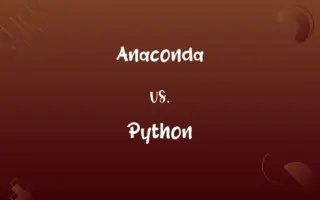Leucoplast vs. Chloroplast: Know the Difference

By Shumaila Saeed || Published on February 29, 2024
Leucoplasts are colorless organelles for storage and synthesis of organic compounds, while chloroplasts are green and responsible for photosynthesis in plants.

Key Differences
Leucoplasts are non-pigmented organelles found in plant cells, mainly involved in the storage and synthesis of starches, oils, and proteins. Chloroplasts, on the other hand, are green-colored organelles crucial for photosynthesis, converting light energy into chemical energy.
Shumaila Saeed
Feb 29, 2024
Leucoplasts are typically found in roots and non-green parts of plants where photosynthesis is not required. Chloroplasts are predominantly present in the green parts of plants, like leaves, where they absorb sunlight and aid in the production of food for the plant.
Shumaila Saeed
Feb 29, 2024
The key function of leucoplasts is to store nutrients and synthesize important biological molecules. In contrast, chloroplasts contain the pigment chlorophyll, which captures sunlight to produce glucose and oxygen from carbon dioxide and water.
Shumaila Saeed
Feb 29, 2024
Leucoplasts, being colorless, do not participate in the photosynthesis process. Chloroplasts, with their green pigment, are essential for this process, thus playing a direct role in the energy cycle of plants and the ecosystem.
Shumaila Saeed
Feb 29, 2024
Structurally, leucoplasts are generally smaller and vary in shape, while chloroplasts are larger with a more defined structure, including thylakoid membranes and stroma necessary for photosynthesis.
Shumaila Saeed
Feb 29, 2024
ADVERTISEMENT
Comparison Chart
Role in Photosynthesis
None
Essential for light absorption and glucose production
Shumaila Saeed
Feb 29, 2024
Structural Features
Smaller, variable shape
Larger, with thylakoids and stroma
Shumaila Saeed
Feb 29, 2024
ADVERTISEMENT
Leucoplast and Chloroplast Definitions
Leucoplast
Colorless organelle in plants for storage and synthesis.
Leucoplasts in potato cells store starch.
Shumaila Saeed
Jan 23, 2024
Chloroplast
Green organelle in plants performing photosynthesis.
Chloroplasts in the leaves capture sunlight for energy.
Shumaila Saeed
Jan 23, 2024
Leucoplast
Organelle in non-photosynthetic tissues of plants.
Leucoplasts are abundant in the roots of plants.
Shumaila Saeed
Jan 23, 2024
Chloroplast
Contains chlorophyll for light absorption in plants.
The green color of leaves is due to chloroplasts.
Shumaila Saeed
Jan 23, 2024
Leucoplast
Involved in the synthesis of fatty acids and amino acids.
Leucoplasts in the plant cells synthesize essential oils.
Shumaila Saeed
Jan 23, 2024
ADVERTISEMENT
Chloroplast
Site of glucose production and oxygen release in plants.
Chloroplasts convert carbon dioxide and water into glucose.
Shumaila Saeed
Jan 23, 2024
Leucoplast
Non-pigmented plastid primarily for storage.
The leucoplasts are responsible for storing oils in the seeds.
Shumaila Saeed
Jan 23, 2024
Chloroplast
Structurally complex with thylakoids and stroma.
The thylakoids in chloroplasts are where photosynthesis occurs.
Shumaila Saeed
Jan 23, 2024
Leucoplast
Plant cell structure storing starch, proteins, and lipids.
In onion cells, leucoplasts store nutrients.
Shumaila Saeed
Jan 23, 2024
Chloroplast
Essential for the conversion of solar energy into chemical energy.
Chloroplasts play a crucial role in the plant's energy cycle.
Shumaila Saeed
Jan 23, 2024
Leucoplast
A colorless plastid in the cytoplasm of plant cells around which starch collects.
Shumaila Saeed
Jan 22, 2024
Chloroplast
A plastid that contains chlorophyll and is found in the cells of green plants and algae.
Shumaila Saeed
Jan 22, 2024
Leucoplast
(biology) An organelle found in certain plant cells, a non-pigmented category of plastid with various biosynthetic functions.
Shumaila Saeed
Jan 22, 2024
Chloroplast
(cytology) An organelle, found in the cells of green plants and in photosynthetic algae, where photosynthesis takes place, characterized by a high concentration of chlorophyll and two membranes.
Shumaila Saeed
Jan 22, 2024
Leucoplast
One of certain very minute whitish or colorless granules occurring in the protoplasm of plants and supposed to be the nuclei around which starch granules will form.
Shumaila Saeed
Jan 22, 2024
Chloroplast
A plastid containing chlorophyll, developed only in cells exposed to the light. Chloroplasts are minute flattened granules, usually occurring in great numbers in the cytoplasm near the cell wall, and consist of a colorless ground substance saturated with chlorophyll pigments. Under light of varying intensity they exhibit phototactic movements. In animals chloroplasts occur only in certain low forms.
Shumaila Saeed
Jan 22, 2024
Chloroplast
Plastid containing chlorophyll and other pigments; in plants that carry out photosynthesis
Shumaila Saeed
Jan 22, 2024
Repeatedly Asked Queries
What is a leucoplast?
A colorless organelle in plant cells for storage and synthesis.
Shumaila Saeed
Feb 29, 2024
What is a chloroplast?
A green organelle in plant cells responsible for photosynthesis.
Shumaila Saeed
Feb 29, 2024
Can leucoplasts be converted into chloroplasts or vice versa?
Under certain conditions, leucoplasts can differentiate into chloroplasts when needed for photosynthesis, or vice versa for nutrient storage.
Shumaila Saeed
Feb 29, 2024
Where do chloroplasts occur?
In green tissues of plants, especially leaves.
Shumaila Saeed
Feb 29, 2024
What is the main function of chloroplasts?
The main function of chloroplasts is to carry out photosynthesis, producing glucose and oxygen from carbon dioxide and sunlight.
Shumaila Saeed
Feb 29, 2024
Can leucoplasts convert into other plastids?
Yes, they can differentiate into other forms.
Shumaila Saeed
Feb 29, 2024
How do the sizes of leucoplasts and chloroplasts compare?
Chloroplasts are typically larger and more complex in structure compared to leucoplasts.
Shumaila Saeed
Feb 29, 2024
Do leucoplasts and chloroplasts play a role in the growth of plants?
Yes, both leucoplasts and chloroplasts are crucial for the growth and development of plants by providing energy and nutrients.
Shumaila Saeed
Feb 29, 2024
What pigment is in chloroplasts?
Chlorophyll, giving them their green color.
Shumaila Saeed
Feb 29, 2024
Do both leucoplasts and chloroplasts have their own DNA?
Yes, both leucoplasts and chloroplasts have their own DNA, which is believed to be a remnant of their evolutionary origins.
Shumaila Saeed
Feb 29, 2024
Are chloroplasts involved in nutrient storage?
Their primary role is photosynthesis, not storage.
Shumaila Saeed
Feb 29, 2024
Can you find both leucoplasts and chloroplasts in the same plant cell?
Yes, plant cells can contain both leucoplasts and chloroplasts, depending on their function and location within the cell.
Shumaila Saeed
Feb 29, 2024
Are there any other types of plastids in plant cells besides leucoplasts and chloroplasts?
Yes, other types of plastids include chromoplasts (responsible for colorful pigments) and amyloplasts (specialized for starch storage).
Shumaila Saeed
Feb 29, 2024
Can you observe leucoplasts and chloroplasts under a microscope?
Yes, both leucoplasts and chloroplasts can be observed and studied using a microscope due to their distinct structures and functions in plant cells.
Shumaila Saeed
Feb 29, 2024
What is the structure of a chloroplast?
Chloroplasts have a double membrane and contain structures like thylakoids, stroma, and grana for photosynthesis.
Shumaila Saeed
Feb 29, 2024
Where are chloroplasts primarily located within plant cells?
Chloroplasts are primarily found in the cells of plant leaves, where they can capture sunlight efficiently.
Shumaila Saeed
Feb 29, 2024
Share this page
Link for your blog / website
HTML
Link to share via messenger
About Author
Written by
Shumaila SaeedShumaila Saeed, an expert content creator with 6 years of experience, specializes in distilling complex topics into easily digestible comparisons, shining a light on the nuances that both inform and educate readers with clarity and accuracy.








































































